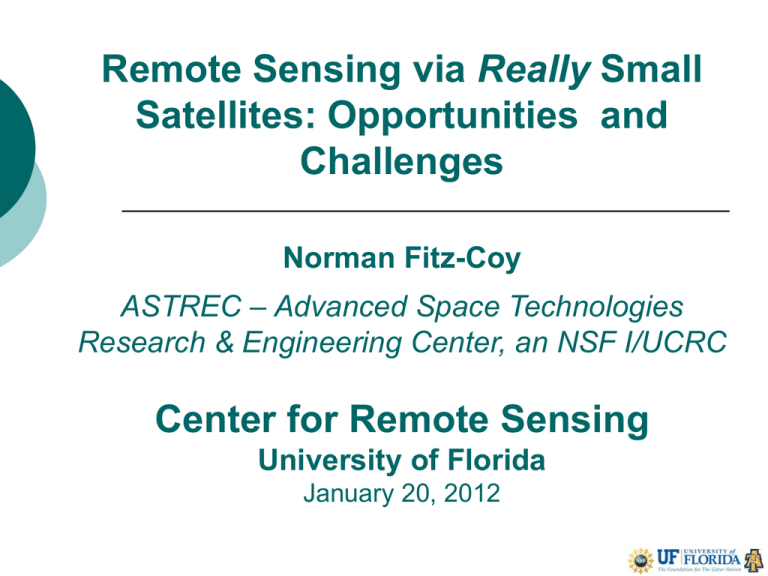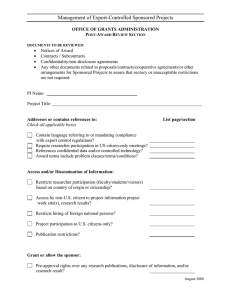Really Satellites: Opportunities and Challenges Center for Remote Sensing
advertisement

Remote Sensing via Really Small Satellites: Opportunities and Challenges Norman Fitz-Coy ASTREC – Advanced Space Technologies Research & Engineering Center, an NSF I/UCRC Center for Remote Sensing University of Florida January 20, 2012 Annual Global Satellite Launches Orbview-3 (last US Remote Sensing satellite) Satellites Launched 140 120 100 80 60 RS Other 40 20 0 Year http://claudelafleur.qc.ca/Scfam-remotesensing.html ASTREC PROPRIETARY Do NOT Reproduce Remote Sensing Satellites (2009-2011) Year Name Classification Country Description 2009 PRISM Nano (5kg) Japan Amateur/Student 2009 Razaksat Mini (180kg) Malaysia Land man., resource develop 2009 Deimos 1 Micro (90kg) Spain Disaster Monitoring Constellation (DMC) 2009 Dubaisat-1 Mini (190kg) Dubai Optical (2.5m BW, 5m RGB) 2009 DMC-2 Micro (96kg) UK DMC 2009 Sumbandila Micro (81kg) SA Ag. monitoring, disaster response, 2009 Oceansar-2 Big (960kg) India 16th remote sensing 2010 Tandem-X Big (1350kg) Germany Formation w/ TerraSAR-X 2010 Cartosat 2b Big (694kg) India Optical (0.8m BW), resource man. 2010 Alsat 2A Mini (116kg) Algerian Resource man, (Alsat 2B later) 2010 Tianhui 1 Chinese 3D mapping 2010 COSMO-Skymed 4 Italian Civil/military reconn (4th in constellation) 2011 Resourcesat-2 India Adv. resource man. (water, agri,…) 2011 Haiyang 2 China Microwave radiometer, ocean map 2011 NigeriaSat 2 Mini (268kg) Nigeria DMC, urban planning, … 2011 Rasat Micro (93kg) Turkey Multispectral imager, Big (1206kg) http://claudelafleur.qc.ca/Scfam-remotesensing.html ASTREC PROPRIETARY Do NOT Reproduce Why Constellations? Improved temporal resolution Spatial distributed observations RapidEye COSMO-SkyMed ASTREC PROPRIETARY Do NOT Reproduce Small Satellite SWaP Characteristics Mini (120 W) Micro (50 W) “CubeSats” Nano 500 kg (20 W) Pico (2 W) 10 kg 100 kg 1kg 10 cm SwampSat (UF) ~30 cm GeneSat (NASA Ames) ~50 cm UK-DMC2 CubeSat Constraints: Size, weight, and power (SWaP) limit ⇒ novel configurations/mission Budget (<<$1M per satellite) ⇒ COTS utilization Development Time ⇒ Less than 1~2 years development cycle ASTREC PROPRIETARY Do NOT Reproduce ~1 m Nigeriasat-2) CubeSats Launched CubeSat Launches (2003-2011) 16 14 12 10 8 6 4 2 0 15 7 6 6 6 5 3 3 Year SwampSat (2012): On-orbit validation of a 3-axis ACS capable of rapid retargeting and precision pointing of CubeSats using control moment gyroscopes (CMGs). ASTREC PROPRIETARY Do NOT Reproduce CubeSats as Remote Sensing Platforms “CubeSat” Paradigm “BigSat” Paradigm Specialized capabilities Multiple copies with the same specialization (redundancy) Global cross-strapping Individual systems less complex (less expensive) Launch campaign for constitution of constellation Duplication of each component Multiple cross-strapping (redundancy) Complex system (expensive) Limited copies “Simpler” launch campaign F1 ... F2 F1 F3 ... ... F4 ASTREC PROPRIETARY F1 F1 F2 F3 F1 F3 F3 F4 F4 F6 Do NOT Reproduce ... ... ... F1 FA F3 FB F3 FA F4 FB F6 Fc ... FA FB ... ... FA FB FC F1 F1 F1 F1 F2 F2 F2 F2 F3 F3 F3 F3 F4 .. . ..F . 4 F4 F4 Fn Fn .. . Fn Fn .. . Potential Launch Options P-POD ASTREC PROPRIETARY NLAS Do NOT Reproduce Ecliptic Sample Mission Disaster Monitoring Using Small Satellites ASTREC PROPRIETARY Do NOT Reproduce Sample Mission Disaster Monitoring: Provide imaging data with a temporal resolution consistent with detection and monitoring Temporal resolution: hourly Spatial resolution: 10-25 m Constellation of LEO satellites ASTREC PROPRIETARY Do NOT Reproduce Challenges: Orbit and/or Debris Mitigation 9 satellites – 3 planes each with 3 satellites Constellation constitution/maintenance Meets 25 yr. orbital life requirement Safety of ISS (alt. ~400 km) Constellation below ISS Or ensure orbit altitude maintenance ASTREC PROPRIETARY Do NOT Reproduce Challenges: Resolution vs. Altitude Resolution at Nadir (m) 2.50 2.00 1.50 D=0.1 D=0.25 1.00 D=0.6 D=1.2 0.50 0.00 100 200 300 400 500 Altitude (km) 600 rd 700 Pixel of ground element Aperture of dia. D R Boresight θ η Edge ray target Image plane f ASTREC PROPRIETARY Do NOT Reproduce ∆x h Challenges: Access Area Instantaneous Access Area (IAA) – all area potentially visible by an instrument or antenna 30.0 25.0 Access Area λ (deg) 20.0 SSP λmax 15.0 10.0 Footprint 5.0 0.0 100 200 300 400 500 Altitude (km) 600 Essentially nadir looking ASTREC PROPRIETARY Do NOT Reproduce 700 Challenges: Constellation Coverage R⊕ R⊕ + h λmax λMax = cos−1 Sat spacing per plane 2π 2 = S = π N 3 cos λstreet = cos λmax cos ( S 2 ) SSP1 Continuous Coverage SSP2 SSP1 (Street of Coverage) S < 2λmax S λmax SSP2 SSP1 Limiting Continuous Coverage S = 2λmax S λmax Intermittent Coverage SSP2 SSP1 S Do NOT Reproduce Street of coverage (continuous coverage) S λmax ASTREC PROPRIETARY λstreet SSP2 S > 2λmax Conclusions Technical challenges Attitude control (pointing accuracy ~ 10s of arcsec) Electrical power (OAP ~10s of watts) High bandwidth communication (data rate ~ 50 Mb/s) Onboard computational power (distributed processing) Deployable structures, thermal control (induces pointing disturbances ) Autonomous orbit control (drag compensation) Dedicated launch opportunities Opportunities (launch, mission, …) ELaNa – NASA’s Educational Launch of Nanosatellites (http://www.nasa.gov/offices/education/centers/kennedy/technology/elana_feature.html) NSF CubeSat based Space Weather and Atmospheric Research (http://www.nsf.gov/pubs/2010/nsf10537/nsf10537.htm) NASA OCT Franklin & Edison Small Sat Program (http://www.nasa.gov/offices/oct/crosscutting_capability/index.html) GENSO (Global Educational Network for Satellite Operations) – Network of university and amateur radio ground stations (www.genso.org) QB50 – Network of 50 CubeSats for in-situ measurements in the lower thermosphere (https://www.qb50.eu/) HumSat – Network of small satellites for humanitarian benefits (www.humsat.org) ASTREC PROPRIETARY Do NOT Reproduce ASTREC PROPRIETARY Do NOT Reproduce ASTREC PROPRIETARY Do NOT Reproduce


